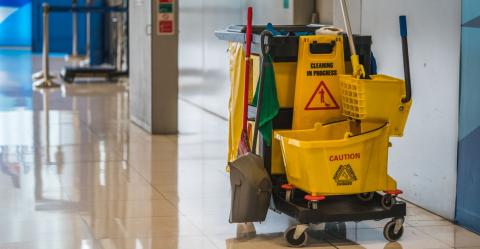
The Covid-19 pandemic has reinforced the importance of surface cleaning as part of creating a safe and healthy workplace. While the cleaning protocols enforced in the early days of the pandemic no longer apply, people in charge of workplaces should learn the lessons of Covid and ensure proper cleaning procedures are followed.
General cleaning and hand hygiene
It is good practice to routinely clean surfaces at your workplace. Clean frequently touched surfaces with detergent solution. Clean general surfaces and fittings when visibly soiled, and immediately after any spillage.
Soap and water can be used for hand hygiene at any time, and should always be used when hands are visibly soiled.
Alcohol-based hand rub (sanitiser) can be used if soap and water are not readily accessible, except when hands are visibly soiled.
Cleaning hands regularly also helps to reduce environmental contamination.
Environmental cleaning procedure
In situations where there is a known risk of exposure to a dangerous substance or pathogen, you will need to follow a rigorous environmental cleaning procedure:
- Wear Personal protective equipment (PPE, see below).
- Work in a well-ventilated area.
- Wipe the area with bleach solution using disposable paper towels or a disposable cloth.
- Clean horizontal and frequently touched surfaces, furniture and fittings.
- Clean windows, sills and frames.
- Clean air conditioning units and dispose of filters.
- Mop the floor.
- Once cleaning is completed, place all disposable cleaning items in a rubbish waste bag. Waste does not require further handling or cleaning measures.
- Clean reusable cleaning items such as mops using hot water, and dry them completely.
- Remove PPE.
- Dispose of PPE in a leakproof plastic bag.
- Wash hands well using soap and water and dry with disposable paper or single-use cloth towel. If water is unavailable, clean hands with alcohol-based hand rub.
Personal protective equipment (PPE)
Personal protective equipment (PPE) for the environmental clean should be put on before entering the work area. Appropriate PPE includes:
- Disposable overalls
- P2/N95 respirator – should be fit-checked with each use
- Face shield or goggles
- Disposable non-sterile gloves (with hand hygiene before putting on and after removing gloves).
Engage an occupational hygienist
You should engage an occupational hygienist to provide guidance on the cleaning requirements and certification at the conclusion of the cleaning process.
The scope of work should involve the following:
- Walkthrough inspection of the property
- Bio tape swab sampling for microbiological contamination
- Laboratory analysis of selected samples by an accredited laboratory
- Preparation of inspection and recommendations report.
Airsafe has occupational hygienists and a group of contractors readily available. We can project manage the environmental clean or provide advice and guidance on the clean-up process.
Call Airsafe now on (02) 9555 9034.
Legislative Requirements
Airsafe’s inspections and reports are always undertaken in accordance with the requirements and principles of the relevant legislation and guidelines, including:
- NSW Work Health and Safety Regulation 2017
- NSW Work Health and Safety Act 2011.



